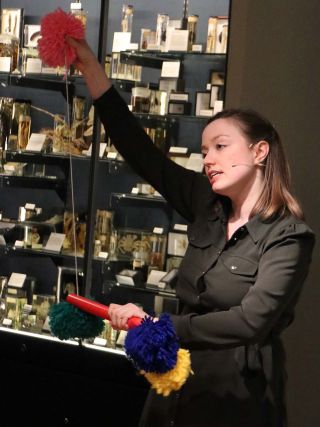Climate Anxiety
Environmental Magic Supports Mental Health
Fun and action can overcome climate anxiety and eco-grief.
Posted February 18, 2024 Reviewed by Jessica Schrader
Key points
- Distress is prevalent due to doomerist reporting of climate change and environmental harm.
- Magician Megan Swann pioneered “environmental magic” to galvanize positive action.
- Tackling eco-crises can be fun and inspirational, supporting positive mental health.
What good could ever come from the “climate crisis” and associated eco-crises? Plenty, if it is positive action—which also supports our mental health.

One pioneer is Megan Swann, a professional magician based in London, U.K. She created and performs “environmental magic,” routines using magic tricks to communicate action on climate change and wider environmental damage. Backstopped by her bachelor of science degree in wildlife conservation, and also working at the British Veterinary Association, Megan applies her scientific knowledge to environmental communication and action through magic.
To link scientists with local artists, my employer University College London (UCL) through UCL Culture funded Megan to use both of our scientific knowledge to create new tricks. We workshopped ideas to understand how climate change and wider environmental science could be integrated into a magic show offering ways forward to a better future. Megan piloted the routine for a Master’s module I coordinated on “Climate Change and Health.” She then performed at UCL’s Grant Museum of Zoology in central London, enrapturing the audience as well as the museum’s specimens—jarred, stuffed, and skeletal.
Environmental magic
The various tricks are ordered according to a storyline of realities, problems, and solutions. Megan’s solid beginning exhibits four pompoms on strings entering a short tube, illustrating the inseparability of people, health, the environment, and the Earth. The connections and integration of the pompoms and the tube display the reality of everything being linked—followed by the reality of our own disconnect from the environments around us, leading to eco-anxiety. Suddenly restored relationships help us get through the difficult times and do much better for ourselves, our mental and physical health, and our planet.
Another trick reuses discarded newspapers. Megan rips one up to demonstrate deforestation. She then amazingly regenerates it to show what happens when we plant trees.
Meanwhile, human-caused climate change looms over humanity and the planet. Megan proffers a balloon to represent the atmosphere, a small black ball as greenhouse gases, and a long needle to represent the Sun’s energy. The miraculous interplay among this trio communicates how and why natural and human-caused climate change happens, alongside what we could and should do to stop our changes to the atmosphere.

The tricks are designed to be close to zero waste. Demonstrating fun, positive action, the limited waste that is produced sometimes becomes the remnants on which the next trick is based. Otherwise, from pulling coloured handkerchiefs out of an empty box to lifting actual environmental successes from decades in the future, all of Megan’s props and materials are sourced from environmentally friendly suppliers, are fully reusable, and are always re-used.
Magic psychology
Why magic? Its performance is often described pejoratively as “misdirecting,” “deceiving our eyes and minds,” “manipulating our attention,” “hexing,” “sleight of hand,” “distorting our perception,” and “forcing our decisions." Its synonyms include “occult,” “voodoo,” “illusions,” and “witchcraft.” Alternatively, rather than undermining a magician’s enemies, magic is viewed as frivolous, childish, pretense, and pure entertainment.
Studies in the psychology of magic show the wonderment it induces, fostering audience engagement and reinforcing educational lessons. Attention, memory, cognition, and reasoning are affected by watching magic tricks—that is their point—so they could be designed and presented to support constructive aspects. Megan does so by directing our attention to actions helping the Earth and humanity.
The challenges are huge. As are our skills and resources. Our efforts and results must and can exceed the scope of the problems.
Megan is certainly no stranger to achievement against the odds. Following a string of awards and prominent appearances, in 2021 she was elected as the youngest and first woman president of The Magic Circle, the London-based 1,700-member-strong famous society for magic, founded in 1905.
This personal success is inspiring. It should convince us all to contribute to planetary and human success in stopping the harm we are causing. This success—through creativity, fun, and action, as epitomized by environmental magic—helps our mental health as well as planetary health.
References
Demacheva, I., M. Ladouceur, E. Steinberg, G. Pogossova, and A. Amir. 2012. The Applied Cognitive Psychology of Attention: A Step Closer to Understanding Magic Tricks. Applied Cognitive Psychology, vol. 26, no. 4, pp. 541-549.
Gustav, K., J.A. Olson, and A. Raz. 2016. Editorial: The Psychology of Magic and the Magic of Psychology. Frontiers in Psychology, vol. 7, article 01358.
Pioread, C. 1914. The psychology of magic. British Journal of Psychology, vol. 7, no. 2, pp. 166-189.


